Archos G9 101 Review
Archos G9 101
Android Honeycomb, a decent screen and sub-£300 price. Should the Galaxy Tab 10.1 be worried?
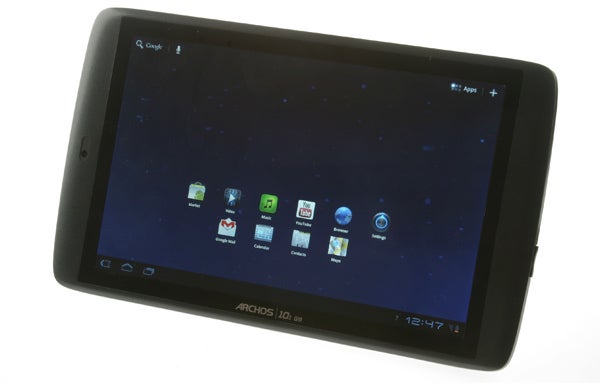
Verdict
Pros
- Reasonable screen
- Superb video support
- Decent value
Cons
- Unattractive
- Intermittently buggy
Key Specifications
- Review Price: £269.99
- 10.1in 1280x800 pixel screen
- Android 3.2 OS
- 8GB flash memory
- miniHDMI output
- 1GHz dual-core Texas Instruments CPU
The G9 101 is the latest in a long line of Archos’s attempts to crack the Android tablet market. None of its previous efforts have quite hit the jackpot, suffering from uninspiring build, rubbish screens and a lack of Android Market support. The Archos G9 101 solves most of these problems, while significantly undercutting the RRP of all the tablet big guns. But it’s not without a sacrifice or two. The question is whether a £100 saving makes these worthwhile.
Functionality-wise the Archos G9 101 is a revelation within the manufacturer’s tablet line-up, boasting both software and hardware more up to the task of offering a satisfying tabular experience than any which came before. However, design-wise, it’s business as usual. If you want a tablet that feels and looks like a slice of gadget heaven, like the Samsung Galaxy Tab 10.1 or iPad 2, this isn’t it.
In a pure design spec sense, it doesn’t sound too bad. 12.6mm thick and weighing 644g, it offers similar dimensions to the Asus Eee Pad Transformer. However, it lacks the solidity and hint of luxury build that several more expensive alternatives have.
It’s a practical and self-conscious design choice to an extent, though. Archos waved goodbye to the oh-so-trendy machined aluminium of the iPad 2 in order to lower costs, instead opting for what it calls plastic overmoulding. Inside the G9 101 is a metal cage housing the tablet’s vital organs, which pokes out as the screen surround – the single bit of metal on show. The rest of the device is covered by two lightly curved bits of metallic grey plastic, which form the front and back of the body.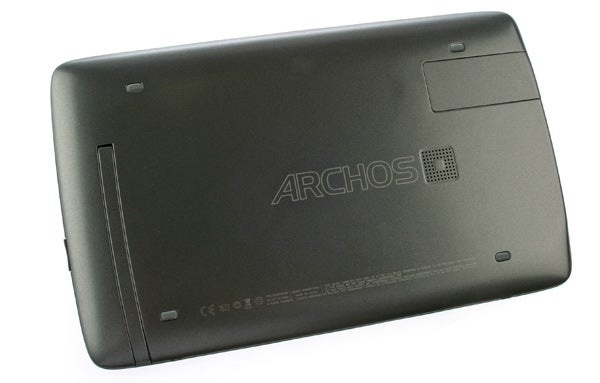
In the never-ending tech war of form versus function, Archos has taken the side of function – which comes with the bonus of practicality. Flip the tablet over and this utilitarian leaning is clear to see. The speaker output is clearly visible – a dotted grill – there are four rubber doodads to protect the body when laid flat, a plastic kick stand cuts deep and conspicuous lines into the chassis and there’s an equally-visible cut-out for the optional 3G stick (a £50 accessory).
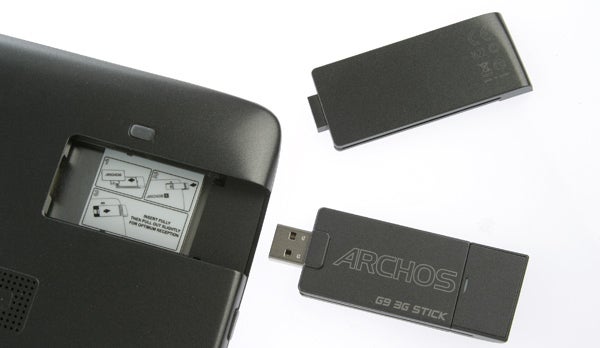
These features give the Archos G9 101 Swiss Army Knife-like flexibility, but also ensure that it’s not a pretty tablet. The kick stand isn’t particularly sturdy, using an all-plastic design that feels weaker than the metal-and-plastic of the previous Archos 101. It easily holds the tablet’s weight, though.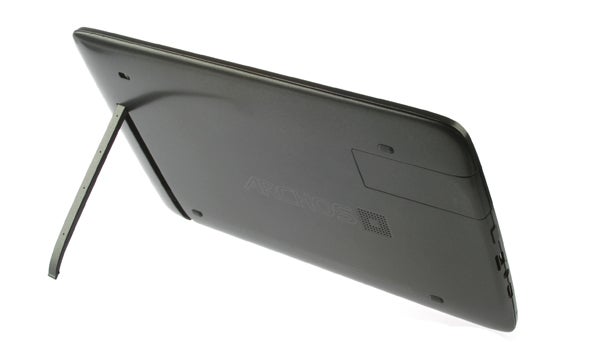
Connectivity is also, predictably, pretty decent. The left edge holds the 3.5mm headphone jack, the screen mirroring microHDMI output, microSD slot and microUSB, used for charging and data transfer. The full-size USB port which the 3G dongle plugs into – covered by a fitted plastic bung when not in use – has bags of potential too. Although not yet activated as a general-purpose USB port, Archos says an incoming firmware update will allow you to attach keyboards, mice and external hard drives. That’s pretty neat, and missing from most Android tablets.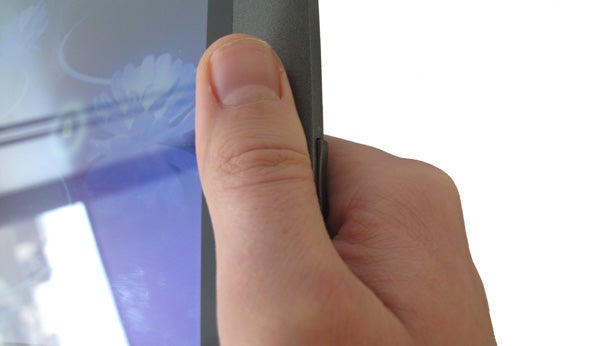
Your hand and the volume control want the same spot, and you can’t win
The practical approach doesn’t always take the user experience into account enough, though – there are downsides other than not being able to feel smug and superior just by holding it. When held “normally”, in landscape orientation with the Archos logo facing the right way up, your hands fall over the volume controls on the right side, and the headphone jack and microHDMI slot on the left. This is a significant usability failing, making it too easy to accidentally change the volume while watching a video – and having a hand over a headphone plug isn’t comfortable. You can adopt Apple’s “you’re holding it wrong” motto, and say the tablet should be gripped lower down, but the most comfortable “natural” grip does raise these problems.
The Archos G9 101 is the first Archos tablet to use version 3.2 Honeycomb of Google’s Android operating system. Although it has produced more than a half-dozen tablets using the OS, this is the first one to use software intended for tablets. Crazy, isn’t it?
The result is that this is easily the least compromised Archos tablet yet. It doesn’t feel as though the software has been stretched to fill the screen’s 10.1 inches, a vibe the first Archos 101 occasionally suffered from. The design philosophy of Android Honeycomb is largely the same as it is in the smartphone 2.x edition of the software, though.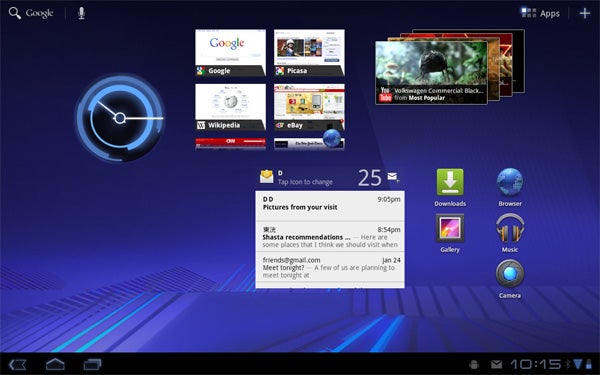
It grants you homescreens that you dump widgets and shortcuts onto – these are your virtual playgrounds – as well as a scrolling apps menu that holds all your apps in icon form. Plenty of widgets don’t quite look right yet on a tablet, but some goodies are starting to seep through, such as HD Widgets. The G9 devices, the 101 and 80, are the first Archos Android tablets to give you Android Market access as standard, and it’s what makes the 101 G9 a viable alternative to more upmarket rivals. While it doesn’t feel “fancy”, you can do everything you can with a Samsung Galaxy Tab 10.1 here – and more besides, as we’ll find out later.
Performance isn’t perfect, though. Android Honeycomb has been available within tablets for more than six months, but we’re yet to see a Honeycomb device that isn’t fairly buggy and prone to unexpected glitches. The Archos G9 101 is worse than most. The most noticeable foibles here are the moments of unresponsiveness. Occasionally, the touchscreen simply refuses to repond for brief intervals. It might be argued that the 512MB of RAM is the bottleneck (most Honeycomb tablets have 512MB), but these never feel like brief load times – rather the products of under-optimised software. It’s as if the G9 101 has fallen asleep with its eyes open. It’s even picky about whether it responds to the power button, refusing to come out of sleep mode like a spotty teenager refusing to get up.
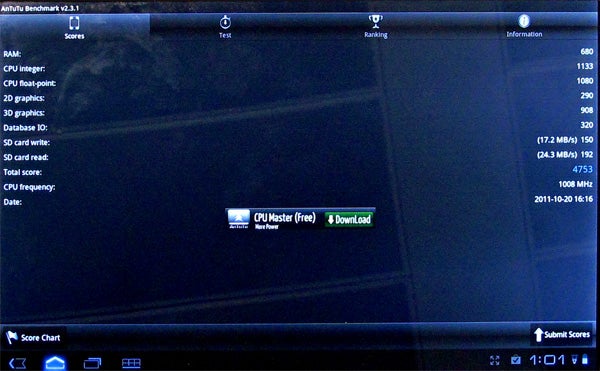
Power on tap is good – day-to-day performance isn’t so hot though
This could also be down, in part, to the processor, but not because of its speed. The G9 101 uses a dual-core 1GHz Texas Instruments processor, rather than the Tegra2 model seen in the vast majority of Honeycomb tablets. This isn’t the reference model for Android 3.x – the Tegra2 chipset is – and the differing architecture can’t have helped. When tested using the AnTuTu benchmarking tool, it performs roughly as well as the Motorola Xoom, a Tegra2 tablet with 1GB of RAM, scoring 4753 points. The last affordable dual-core tablet we tested, the Time2Touch HC701A, scored just 2870.
If you can cope with the odd pause and moment of unresponsiveness, the Archos G9 101 has the power to handle high-powered Androids app and games easily. However, we found the erratic behaviour a continued annoyance, rather than something you just get used to. Hopefully Archos will remedy this with a software update. But for now this is buggier than the other Honeycomb tablet’s we’ve tested.
One of our key complaints about the last batch of Archos tablets, the 70 and 101, was that the screen quality wasn’t great. Turn the screen the wrong way and the image would almost disappear – it’s an effect known as contrast shift and it affects almost all budget tablets and the vast majority of laptops.
The Apple iPad blasted away contrast shift problems with its IPS screen, thereby setting the standard by which all subsequent tablets would be judged. Archos’s G9 101 doesn’t have an IPS display, but it does offer remarkably good performance. Tilt the screen to as extreme an angle as you like and the image on-screen will stay perfectly visible. Archos deserves a pat on the back for including such a good panel in an affordable tablet – the similarly-priced Acer Iconia A100 didn’t.
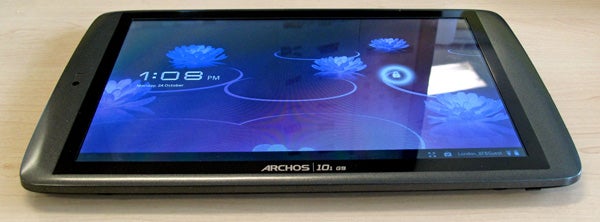
Viewing angles = good, but it’s highly reflective
That said, contrast, black levels and colour reproduction can’t quite match the best tablet displays out there and the surface is highly reflective. Others 10.1in Android tablets offer a punchier image, although the 1280×800 pixel resolution is the same as you’ll find in every 10.1in Honeycomb tablet in town. This gives a pixel density of 149ppi – very low compared with the top smartphones, but still sufficient, as you tend to hold a tablet further away than a smartphone. It’s much sharper than the previous-gen Archos 101, which had a 1024×600 screen, with a pixel density of 117ppi.
The top-most screen layer is hard plastic rather than glass – and as such doesn’t feel quite as glorious under your finger as an iPad 2 screen. Tapping on it a bit harder than usual causes the screen to flash white momentarily too, which is a bit worrying and may be a bad indicator of its longevity. The touch layer is capacitive, though, and very responsive when not affected by the core software’s buggy bits. Multi-touch is fully supported, and while its ability to sense four points of contact at once is just “mid-range” in performance terms, it’s easily enough for any gestures we’ve come across.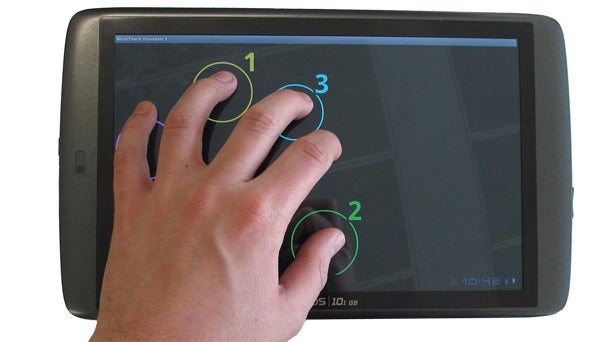
This enables the usually pinch zooming web browsing gesture, and helps to make the G9 101 a decent sofa web surfer. Equip it with a 3G dongle and it’ll do the same while you’re out, although the widescreen aspect ratio makes it feel unwieldy when held upright. Unless you can hold it in two hands, this isn’t the best tablet to be lumbered with – like other 10.1 Android tablets. The 4:3 aspect ratio of the iPad may not seem great for movies, but it is more comfortable to hold one-handed and feels altogether more compact – and Archos even offers its own tablet this shape, the Archos G9 80. We’ll be back with a review of that model soon.
Assuming you’re using it in a fairly favourable environment, the Archos G9 101 is very usable. The virtual keyboard is large and accurate, whether you’re tapping away in portrait or landscape aspects, and full Flash 10.1 support is on hand too. It’s just a pity that its operation isn’t a little smoother and that run-ins with bugs are quite so common.
Before the smartphone revolution, Archos used to make the best PMP (personal media players) around. They were basically MP3 players with good video codec support and, usually, large enough screens to watch a movie on. Like hard drive MP3 players, PMPs have all-but bitten the dust, but the G9 101 boasts several fantastic benefits of its heritage.
The Archos G9 101 is the best Android tablet at playing video, bar none. It handles almost all of the most popular codecs used online, including DivX, XviD and MKV – missing from all of the cheaper top-end tablets including the Asus Eee Pad Transformer and Motorola Xoom. We fed the tablet reams of video types and it never failed. It played our challenging 42mbps 1080p MKV flawlessly, cementing its position as the class leader in this respect.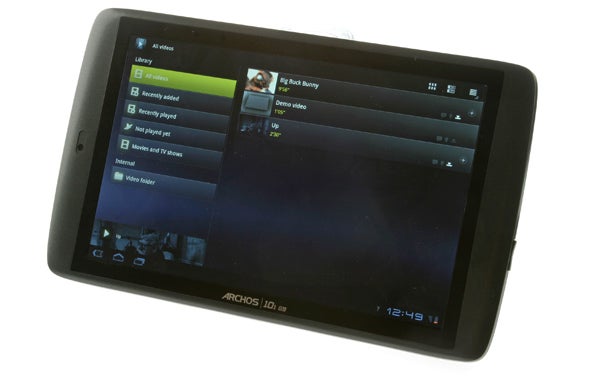
There are two minor quibbles with the overall video experience, though. The first is that, good viewing angles aside, you’ll find better displays elsewhere. Archos also charges a premium for its Cinema plug-in, which enables AC3 5.1 audio and the MPEG2 HD video codec. This is only worth worrying about if you intend to make the G9 101 a home media player, using the miniHDMI output – because 5.1 audio isn’t much use when being pumped out of weedy internal speakers or a stereo headphone jack. The video output mirrors what’s displayed on-screen, which is the simplest and easiest way to go about a tablet video out.
Archos has given its media player a complete overhaul alongside the launch of the G9 series. The same menu look is still here, which we’re not huge fans of, but it now also sports a neat cover flow-style video select system. This grabs a still from each video, using it as a preview image, and displatys them as an animated carousel. Flicking through this visually flash video browser is smooth and fast – and you can filter your videos to include only recently-added files, or those not yet watched. You can also link movies to their respective IMDB listings, integrating loads of details such as cast members, official artwork and so on.
Like its codec library, the media player is simply much better than what you get in almost every other Android Honeycomb tablet. Some might argue that the limited video support of other tabs can be remedied with third-party apps, but in our experience the lack of proper hardware acceleration means they tend to struggle with even 720p content. The G9 101 sails through most 1080p videos. Battery life when playing video is good too. It lasted a solid eight hours off a full charge when playing back a standard definition Divx video on loop.
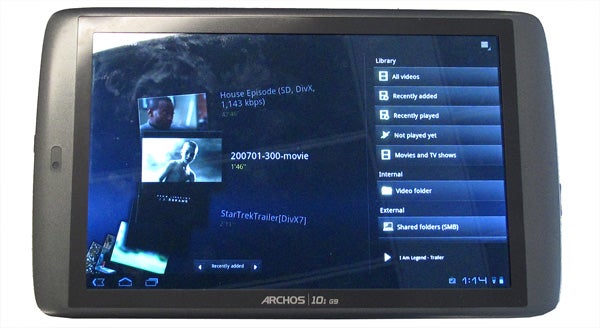
The Archos G9 101 handles music in a similar way to films, offering the same nav interface, complete with natty cover flow system. Codec support here is also very good, including FLAC and OGG on top of the standards MP3, WAV and AAC. These are often left out of £100 dedicated MP3 players, and it’s great to see them show up here. We would argue that the G9 101 is almost useless as a portable MP3 player, though. It’s far too big, and even with a large-capacity microSD card installed, the size-to-storage ratio is awful.
Just as its microHDMI slot makes it handy as a home movie hub, there are some features that make it worth considering as an at-home audio player, aside from the decent format support. Built-in Bluetooth lets you connect to a compatible wireless speaker or audio sender, the Archos Remote app lets you control playback on the tablet using a smartphone and – failing the wireless option – the output from the 3.5mm headphone output is nice and clean. 
Some other tablets we’ve tested, including previous Archos models, have audio outputs very prone to interference – and hence tend to sound rubbish. For a real multimedia powerhouse, it’s worth waiting for the 250GB editions of the G9 tablets – the premium you have to pay isn’t too painful. The 8GB of internal memory matched with a 32GB microSD card gives a potential storage of 40GB, which doesn’t get near to matching this slightly chunkier hard drive edition.
A strength of the new G9 range is that it differentiates itself from the competition conspicuously with several of its models. The Archos G9 101’s issue is that we’re not quite sure it necessarily has enough to make up for its drab looks and cheap-feeling body. If it had come out alongside its rivals earlier this year, when the Eee Pad Transformer cost £379.99 (sans keyboard) and the Motorola Xoom a solid £449.99, the Archos G9 101 would have seemed like undeniably cracking value. 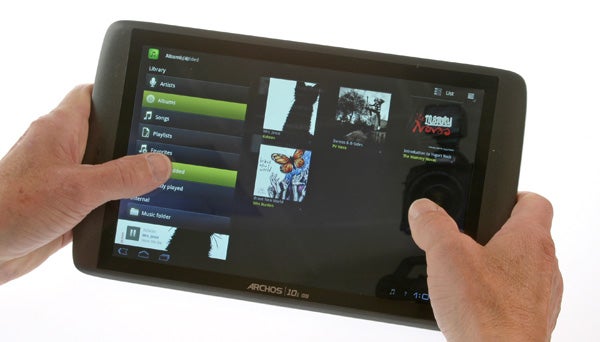
Its problem is that both these early Honeycomb entries now sell for £329.99 – just £60 more than the Archos. And recently, the BlackBerry PlayBook and Acer Iconia A500 have been on sale for less than the Archos G9 101. This tablet beats them all with its video support, but then both have much more of the desirability factor that’s become a key part of the tablet allure.
And what of proper budget alternatives? The outlook is pretty bare at present, but several promising contenders are on the way. Viewsonic’s ViewPad 10e offers a 9.7in IPS screen, just like the iPad, a 1GHz (single core) processor and Android Gingerbread for £199.99, while the Amazon Kindle Fire won’t cost more than £199.99 given it’s set to ship in the US for $199.99 in just a few weeks. Archos’s G9 101 isn’t going to seem very cheap for very long.
Verdict
This is the most capable Android Honeycomb video player. Format support is excellent, the screen’s decent and battery life compares fairly well with more expensive tablets. The power’s there too – its dual-core 1GHz processor able to handle high bit-rate 1080p content with ease. What’s wrong, then? It’s the design and general performance. The plastic body just doesn’t feel as nice as any of the pricier models, and several on-body bits get in the way while you’re holding it. Plus there are just too many buggy bits to make it particularly enjoyable to use. When much more luxurious tablets like the Acer A500 and BlackBerry PlayBook are now available for less, the G9 proposition just isn’t that convincing. It’s just a bit too late.
How we test tablets
We test every tablet we review thoroughly. We use industry standard tests to compare features properly and we use the tablet as our main device over the review period. We’ll always tell you what we find and we never, ever, accept money to review a product.
Trusted Score
Score in detail
-
Performance 5
-
Value 7
-
Design 5
-
Features 8
-
Battery Life 8


